Influence of Coarse Aggregate Exposure on Air Purification Efficiency in Photocatalytic Cement Composites
Abstract
1. Introduction
2. Materials and Methods
2.1. Materials
2.2. Experimental Framework
2.3. Methods
2.3.1. Digital Image Analysis—The Surface Area Occupied by Coarse Aggregate on Samples with Exposed Aggregate
2.3.2. Air Purification Efficiency from NOx Pollutants
2.3.3. Slip Resistance and Compressive Strength
3. Results
3.1. Compressive Strength and Surface Area Covered with Cement Matrix
3.2. Slip Resistance
3.3. Air Purification from NO
4. Discussion
- —NO removal rate (combined light), µg/hm2;
- —NO removal rate (visible light), µg/hm2;
- AECM—area of exposed cement matrix on the surface of specimen, %.
5. Conclusions
- Exposed coarse aggregate can act as a carrier for photocatalytic nano modifiers, effectively immobilizing nanoparticles on its exposed external surface;
- The photocatalytic performance of cementitious composites is significantly impacted by the characteristics of the photoactive surface, including its roughness and exposure of photocatalyst grains to external conditions;
- Photocatalytic concretes with exposed coarse aggregate were characterized with a lower photocatalytic efficiency—this effect can be overcome through additional technological steps, which would increase the amount of TiO2 grains immobilized on the surface of the aggregate (soaking coarse aggregate in TiO2 solution prior to concrete mix preparation, etc.);
- Exposing the coarse aggregate contributed to an increase in the slip resistance of modified cementitious composites;
- A significant photocatalytic performance of cementitious composites modified by a first-generation photocatalyst (P25) was observed in the low UV-a irradiation conditions (1 W/m2), simulating the autumn/winter conditions in Central and Northern Europe.
Author Contributions
Funding
Data Availability Statement
Conflicts of Interest
References
- Nazarenko, Y.; Pala, D.; Ariya, P.A. Air Quality Standards for the Concentration of Particulate Matter 2.5, Global Descriptive Analysis. Bull. World Health Organ. 2021, 99, 125–137D. [Google Scholar] [CrossRef]
- Al-Raqeb, H.; Ghaffar, S.H.; Al-Kheetan, M.J.; Chougan, M. Understanding the Challenges of Construction Demolition Waste Management Towards Circular Construction: Kuwait Stakeholder’s Perspective. Clean. Waste Syst. 2023, 4, 100075. [Google Scholar] [CrossRef]
- Ramacher, M.O.P.; Matthias, V.; Aulinger, A.; Quante, M.; Bieser, J.; Karl, M. Contributions of Traffic and Shipping Emissions to City-Scale NOx and PM2.5 Exposure in Hamburg. Atmos. Environ. 2020, 237, 117674. [Google Scholar] [CrossRef]
- EEA. Harm to Human Health from Air Pollution in Europe: Burden of Disease 2023. ETC HE Rep. 2023, 7, 104. [Google Scholar]
- Mata, T.M.; Martins, A.A.; Calheiros, C.S.; Villanueva, F.; Alonso-Cuevilla, N.P.; Gabriel, M.F.; Silva, G.V. Indoor Air Quality: A Review of Cleaning Technologies. Environments 2022, 9, 118. [Google Scholar] [CrossRef]
- Holnicki, P.; Kałuszko, A.; Nahorski, Z. A Projection of Environmental Impact of a Low Emission Zone Planned in Warsaw, Poland. Sustainability 2023, 15, 16260. [Google Scholar] [CrossRef]
- Chen, X.; Qiao, L.; Zhao, R.; Wu, J.; Gao, J.; Li, L.; Falletta, E. Recent Advances in Photocatalysis on Cement-Based Materials. J. Environ. Chem. Eng. 2023, 11, 109416. [Google Scholar] [CrossRef]
- Kalinowski, M.; Chilmon, K.; Jackiewicz-Rek, W.; Rakowski, B. The Influence of Selected Material Variables of Photocatalytic Cementitious Composites on the Self-Cleaning Properties and Air Purification Efficiency from NOx Pollutants. Sustainability 2023, 15, 853. [Google Scholar] [CrossRef]
- Li, C.; Wang, J.; Guo, H.; Ding, S. Low Temperature Synthesis of Polyaniline–Crystalline TiO2–Halloysite Composite Nanotubes with Enhanced Visible Light Photocatalytic Activity. J. Colloid Interface Sci. 2015, 458, 1–13. [Google Scholar] [CrossRef]
- Jędrzejczak, P.; Janczarek, M.; Parus, A.; Gapiński, B.; Hotěk, P.; Fiala, L.; Klapiszewski, Ł. Carbon-Modified TiO2 as a Promising and Efficient Admixture for Cementitious Composites: A Comprehensive Study of Photocatalytic, Mechanical and Structural Properties. J. Build. Eng. 2023, 78, 107747. [Google Scholar] [CrossRef]
- Zhao, A.; Yang, J.; Yang, E.H. Self-Cleaning Engineered Cementitious Composites. Cem. Concr. Compos. 2015, 64, 74–83. [Google Scholar] [CrossRef]
- Witkowski, H.; Jackiewicz-Rek, W.; Chilmon, K.; Jarosławski, J.; Tryfon-Bojarska, A.; Gąsiński, A. Air Purification Performance of Photocatalytic Concrete Paving Blocks after Seven Years of Service. Appl. Sci. 2019, 9, 1735. [Google Scholar] [CrossRef]
- Mishra, A.; Mehta, A.; Basu, S. Clay Supported TiO2 Nanoparticles for Photocatalytic Degradation of Environmental Pollutants: A Review. J. Environ. Chem. Eng. 2018, 6, 6088–6107. [Google Scholar] [CrossRef]
- Gang, L.; Wu, Y. Upcycling of waste concrete powder into a functionalized host for nano-TiO2 photocatalyst: Binding mechanism and enhanced photocatalytic efficiency. J. Clean. Prod. 2022, 366, 132918. [Google Scholar] [CrossRef]
- Witkowski, H.; Jarosławski, J.; Szkop, A.; Chilmon, K.; Kalinowski, M.; Jackiewicz-Rek, W. The Potential Risk of Nanoparticulate Release from Photocatalytic Pavement Concrete Surface Due to a Simulated Abrasion Load—An Experimental Study. Materials 2024, 17, 3022. [Google Scholar] [CrossRef] [PubMed]
- Boonen, E.; Beeldens, A. Recent Photocatalytic Applications for Air Purification in Belgium. Coatings 2014, 4, 553–573. [Google Scholar] [CrossRef]
- Guo, M.-Z.; Ling, T.-C.; Poon, C.S. Photocatalytic NOx degradation of concrete surface layers intermixed and spray-coated with nano-TiO2: Influence of experimental factors. Cem. Concr. Compos. 2017, 83, 279–289. [Google Scholar] [CrossRef]
- Wang, F.; Yang, L.; Wang, H.; Yu, H. Facile preparation of photocatalytic exposed aggregate concrete with highly efficient and stable catalytic performance. Chem. Eng. J. 2015, 264, 577–586. [Google Scholar] [CrossRef]
- Yang, Y.; Yan, Z.; Yang, S.; Tang, Z.; Li, W.; Yang, B.; Su, W.; Ji, T. Effect of substrate roughness on NOx removal of poly heptazine imides coated cement pastes exposed to washing and weathering. J. Clean. Prod. 2022, 377, 134397. [Google Scholar] [CrossRef]
- Zhang, J.; Tan, H.; Deng, X. NOx removal ability of photocatalytic cement-based materials with porous structure. J. Clean. Prod. 2022, 377, 134396. [Google Scholar] [CrossRef]
- PN-EN 197-1:2012; Cement Composition, Specifications and Conformity Criteria for Common Cements. PKN—The Polish Committee for Standardization: Warsaw, Poland, 2012.
- PN-EN 196-1:2016-07; Methods of Testing Cement—Part1: Determination of Strength. PKN—The Polish Committee for Standardization: Warsaw, Poland, 2016.
- PN-EN 196-3:2016; Methods of Testing Cement—Part 3: Determination of Setting Times and Soundness. PKN—The Polish Committee for Standardization: Warsaw, Poland, 2016.
- PN-EN 933-1:2012; Tests for Geometrical Properties of Aggregates—Part 1: Determination of Particle Size Distribution—Sieving Method. Polish Committee for Standardization: Warsaw, Poland, 2012.
- PN-B-06714-46; Mineral Aggregates—Tests—Determination of Potential Alkaline Reactivity Using the Rapid Method. Polish Committee for Standardization: Warsaw, Poland, 1992.
- PN-EN 1744-1+A1:2013; Tests for Chemical Properties of Aggregates—Part 1: Chemical Analysis. Polish Committee for Standardization: Warsaw, Poland, 2013.
- PN-EN 1008:2004; Mixing Water for Concrete—Specification for Sampling, Testing and Assessment of Suitability of Mixing Water for Concrete, Including Water Recovered from Concrete Production Processes. Polish Committee for Standardization: Warsaw, Poland, 2004.
- PN-EN 934-2+A1:2012; Admixtures for Concrete, Mortar and Cement Paste—Part 2: Admixtures for Concrete—Definitions, Requirements, Compliance, Marking and Labelling. Polish Committee for Standardization: Warsaw, Poland, 2012.
- PN-EN 12350-2:2019-07; Concrete Mix Testing—Part 2: Consistency Test Using the Slump Cone Method. PKN—The Polish Committee for Standardization: Warsaw, Poland, 2019.
- ISO 22197-1:2016; Fine Ceramics (advanced Ceramics, Advanced Technical Ceramics)—Test Method For Air-Purification Performance of Semiconducting Photocatalytic Materials. Part 1: Removal of nitric oxide. ISO (the International Organization for Standardization): Geneva, Switzerland, 2016.
- PN-EN 13036-4:2011; Method for Measurement of Slip/Skid Resistance of a Surface: The Pendulum Test. PKN—The Polish Committee for Standardization: Warsaw, Poland, 2011.
- PN-EN 12390-3:2019-07; Testing Hardened Concrete—Part 3: Compressive Strength of Test Specimens. PKN—The Polish Committee for Standardization: Warsaw, Poland, 2019.
- PN-EN 206+A2:2021; Concrete—Specification, performance, production and conformity. Polish Committee for Standardization: Warsaw, Poland, 2021.
- Haghighatmamaghani, A.; Haghighat, F.; Lee, C.S. Performance of Various Commercial TiO2 in Photocatalytic Degradation of a Mixture of Indoor Air Pollutants: Effect of Photocatalyst and Operating Parameters. Sci. Technol. Built Environ. 2019, 25, 600–614. [Google Scholar] [CrossRef]
- Zhang, Y.; Zhou, Y.; Dong, X.; Xi, X.; Dong, P. Recent advances in TiO2-based photocatalytic concrete: Synthesis strategies, structure characteristics, multifunctional applications, and CFD simulation. Chem. Eng. J. 2024, 496, 154186. [Google Scholar] [CrossRef]
- Kalinowski, M.; Woyciechowski, P.; Jackiewicz-Rek, W. Surface Modification of Photocatalytic Cementitious Composites with Polyacrylic Superabsorbent Polymers (SAP). Mater. Proc. 2023, 13, 23. [Google Scholar] [CrossRef]
- Sikkema, J.K.; Ong, S.K.; Alleman, J.E. Photocatalytic concrete pavements: Laboratory investigation of NO oxidation rate under varied environmental conditions. Constr. Build. Mater. 2015, 100, 305–314. [Google Scholar] [CrossRef]
- Szołdra, P.; Frąc, M.; Pichór, W. Photocatalytic degradation of nitrogen oxides (NOx) in a continuous-flow photoreactor with aluminosilicate microspheres coated with TiO2 thin films. Chem. Eng. Process. —Process Intensif. 2024, 202, 109856. [Google Scholar] [CrossRef]
- Liu, D.; Kaja, A.; Chen, Y.; Brouwers, H.J.H.; Yu, Q. Self-cleaning performance of photocatalytic cement mortar: Synergistic effects of hydration and carbonation. Cem. Concr. Res. 2022, 162, 107009. [Google Scholar] [CrossRef]
- Deysel, R.C.; Boshoff, W.P.; Smit, M.S. Implementing capillary pressure control measures to prevent plastic shrinkage cracking in concrete. Constr. Build. Mater. 2023, 397, 132407. [Google Scholar] [CrossRef]
- Nasir, M.; Alimi, W.O.; Oladapo, E.A.; Imran, M.; Kazmi, Z.A. Behavior of drying and plastic shrinkage of Portland cement concrete prepared and cured under harsh field. Dev. Built Environ. 2023, 16, 100252. [Google Scholar] [CrossRef]
- Jin, S.; Zhang, J.; Han, S. Fractal analysis of relation between strength and pore structure of hardened mortar. Constr. Build. Mater. 2017, 135, 1–7. [Google Scholar] [CrossRef]
- Ren, J.; Luo, X.; Bai, R.; Pan, C.; Zhang, J. Pore characteristics of different phase in nano-modified concrete and their influences on the compressive strength. J. Build. Eng. 2022, 46, 103784. [Google Scholar] [CrossRef]
- Li, Z.; Wang, J.L.; Li, Y.; Yu, X.; Han, B.G. Investigating size effect of anatase phase nano-TiO2 on the property of cement-based composites. Mater. Res. Express. 2018, 5, 085034. [Google Scholar] [CrossRef]
- Choi, Y.-C. Impact of TiO2 powder type on hydration and photocatalytic NOx degradation in cement paste. Results Eng. 2024, 24, 103187. [Google Scholar] [CrossRef]
- Kalinowski, M.; Chilmon, K.; Bogacki, J.; Woyciechowski, P. Organic and Inorganic Modifications to Increase the Efficiency in Immobilization of Heavy Metal (Zn) in Cementitious Composites—The Impact of Cement Matrix Pore Network Characteristics. Materials 2024, 17, 5281. [Google Scholar] [CrossRef] [PubMed]
- Yang, Z.; Xu, Y.; Cai, X.; Wu, J.; Wang, J. Studying properties of pervious concrete containing recycled aggregate loaded with TiO2/LDHs and its liquid pollutant purification. Constr. Build. Mater. 2023, 406, 133398. [Google Scholar] [CrossRef]
- Chen, X.-F.; Jiao, C.-J. A photocatalytic mortar prepared by tourmaline and TiO2 treated recycled aggregates and its air-purifying performance. Case Stud. Constr. Mater. 2022, 16, e01073. [Google Scholar] [CrossRef]

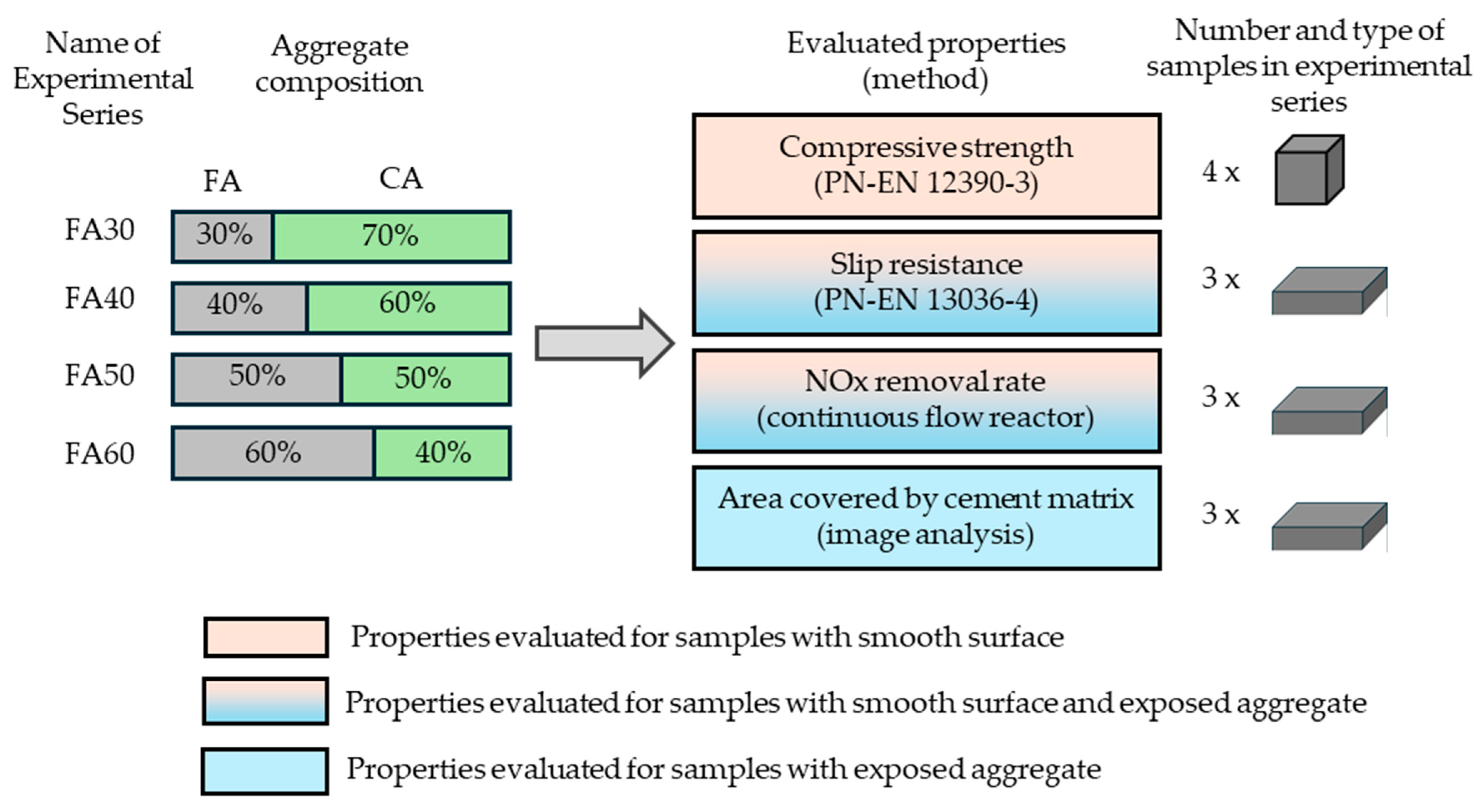
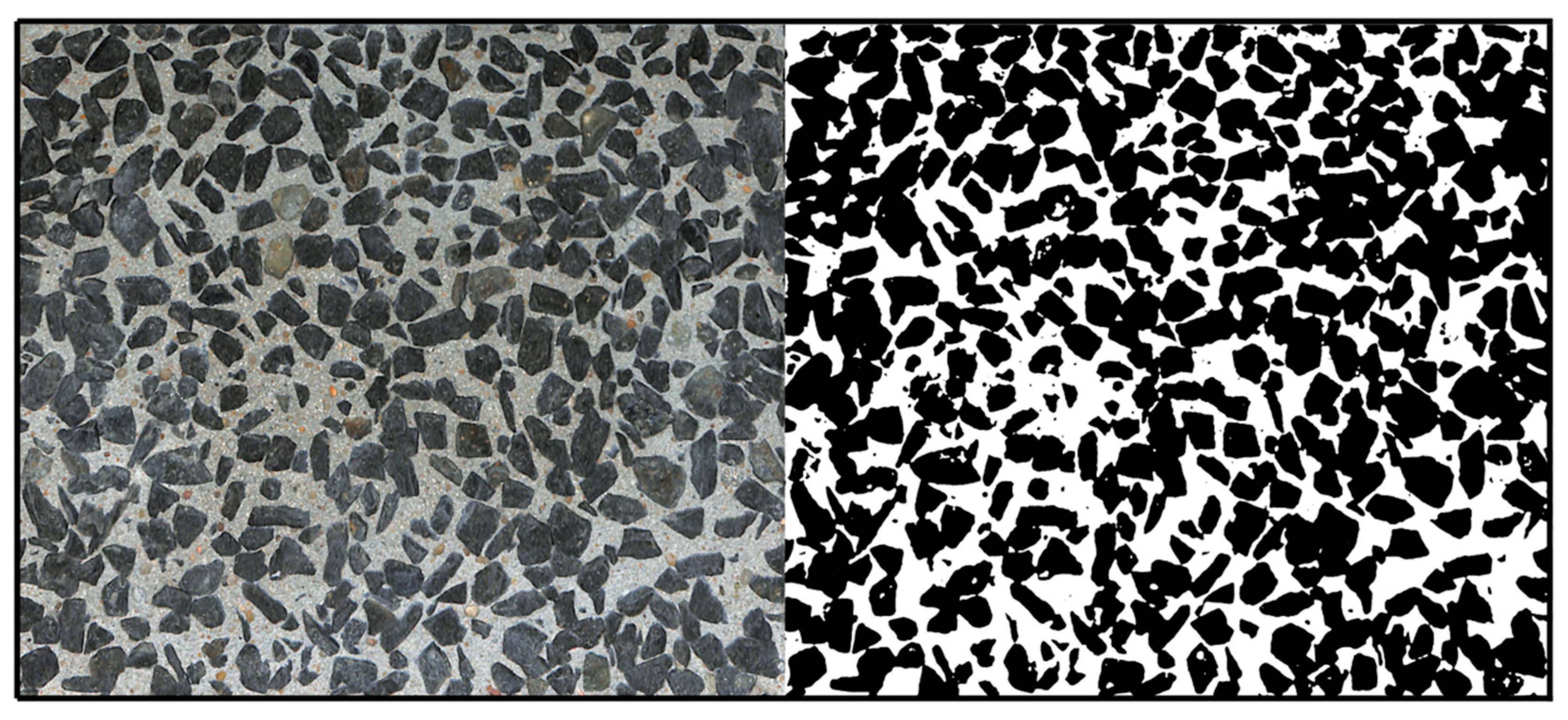

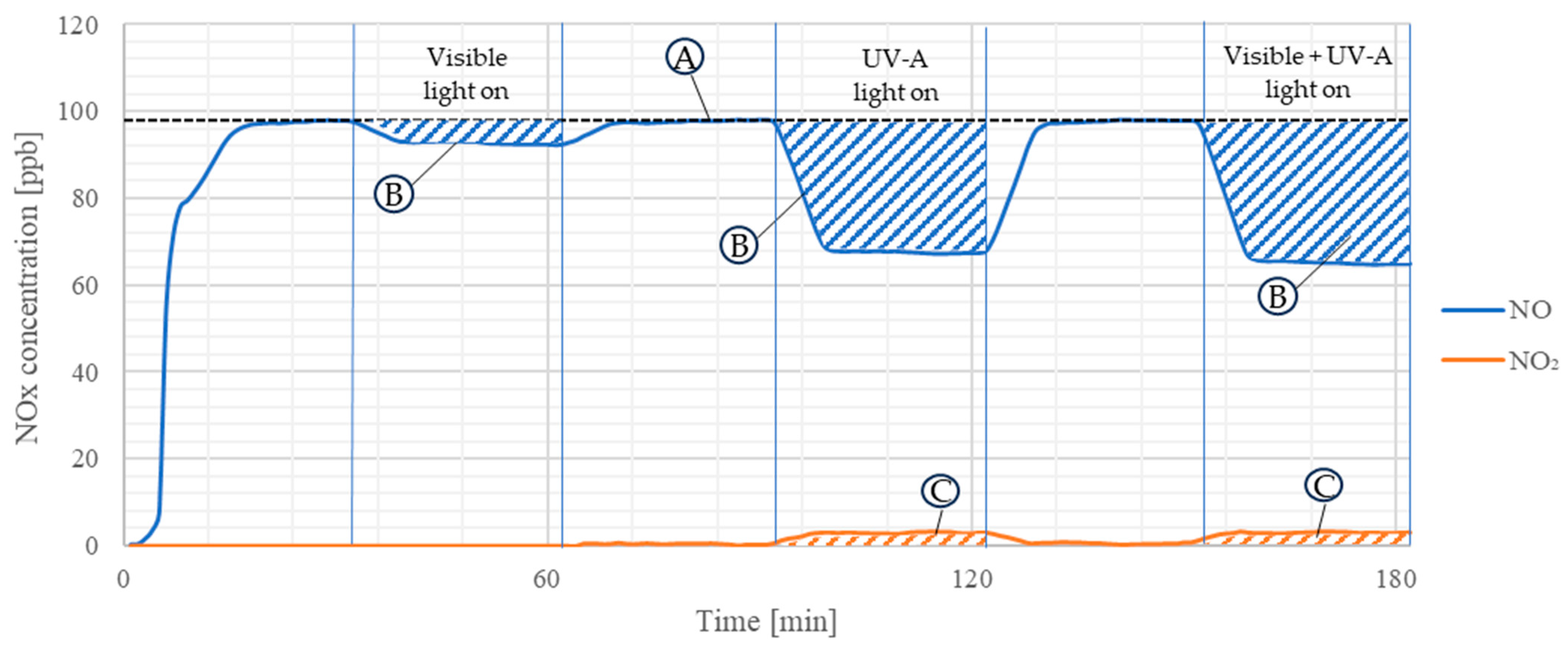
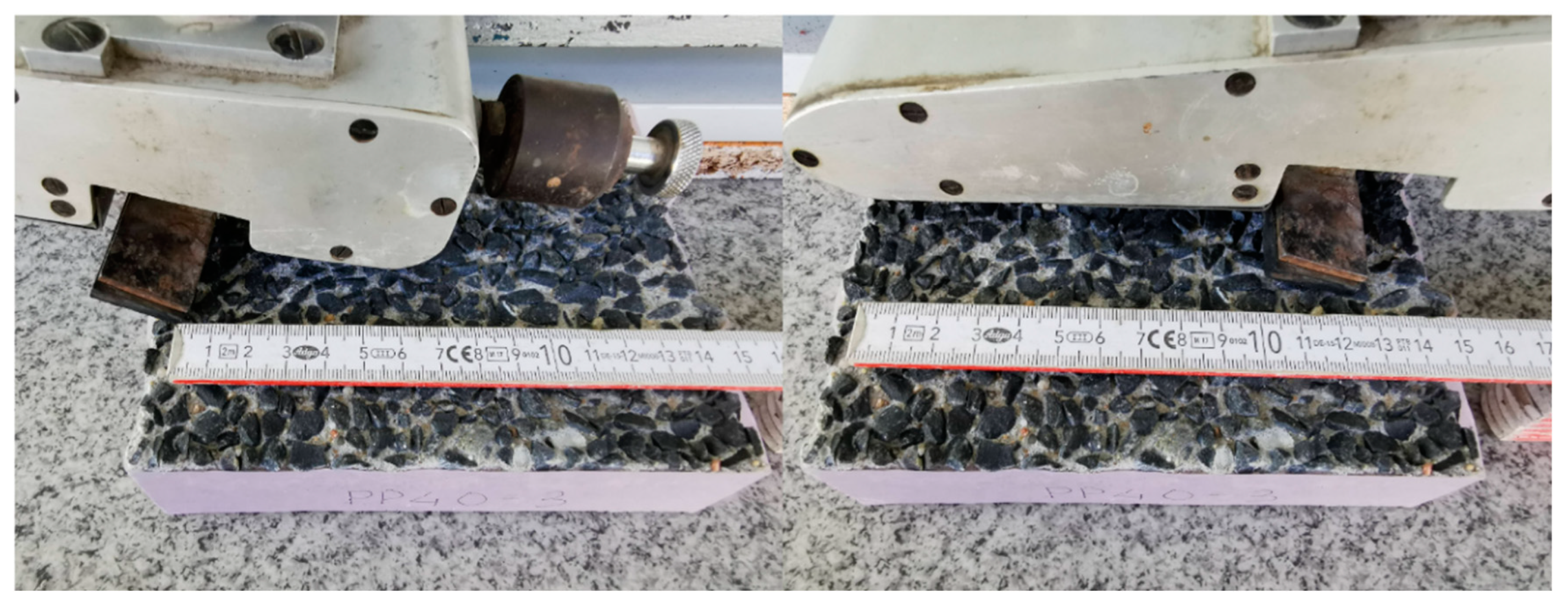
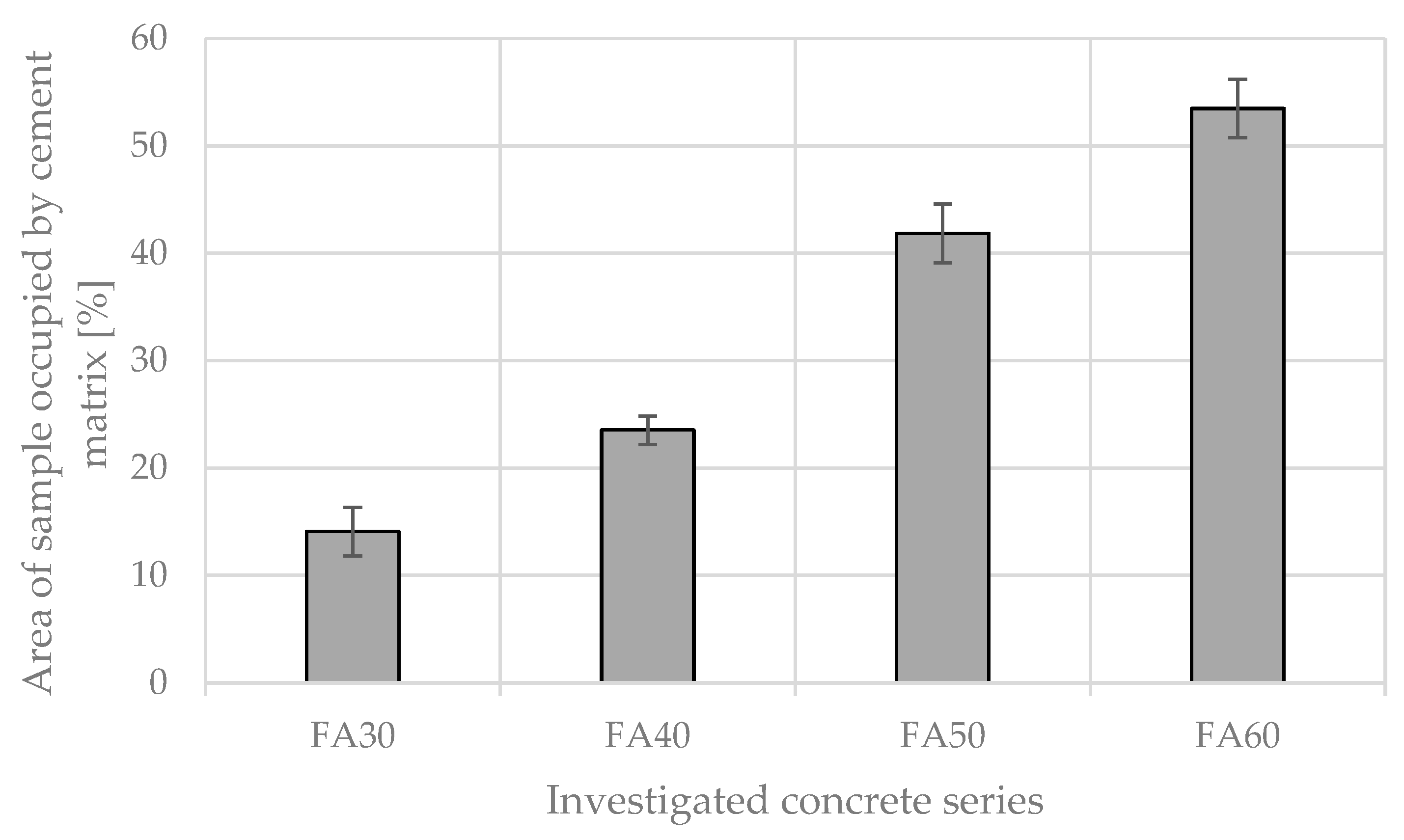
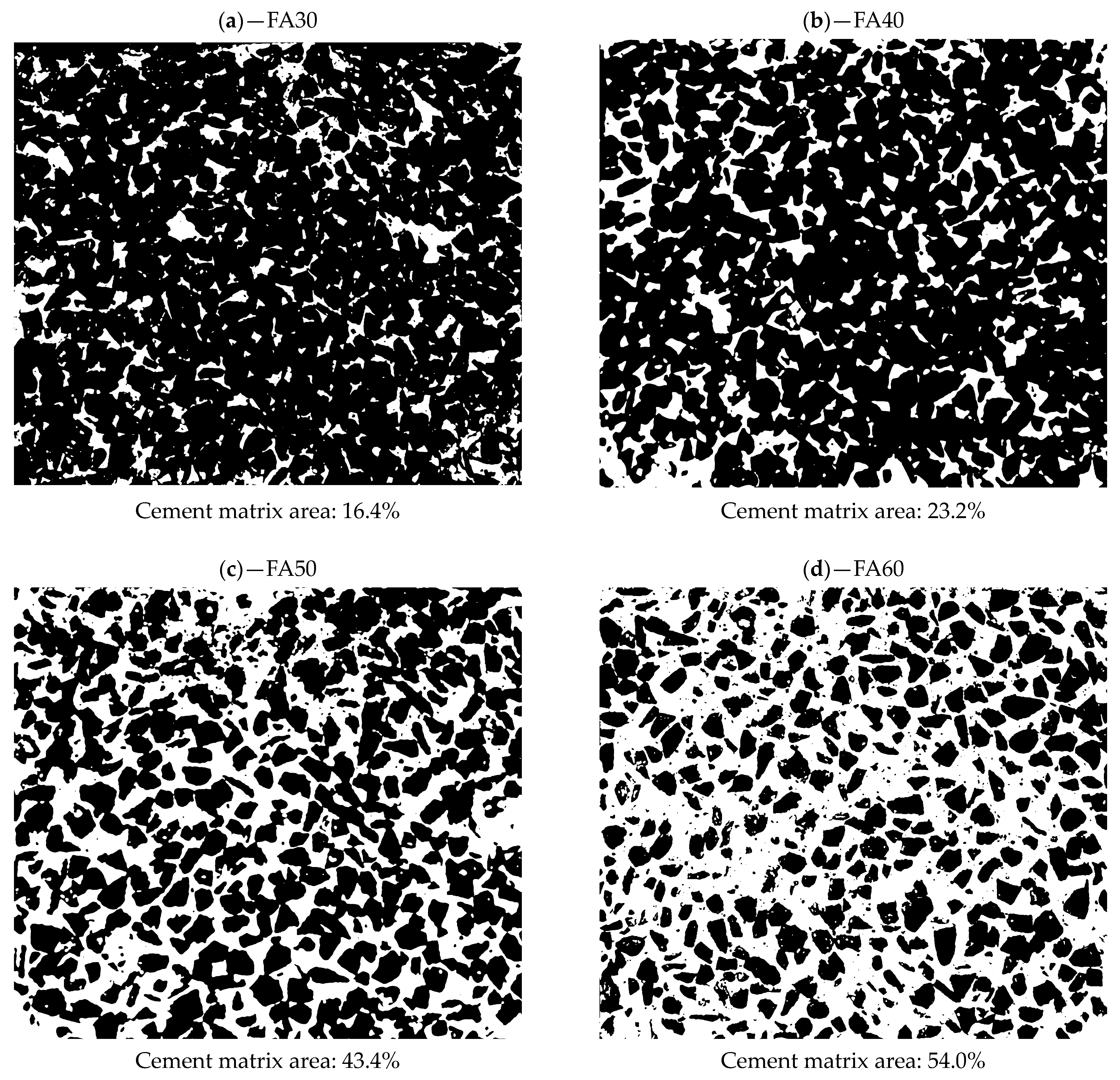

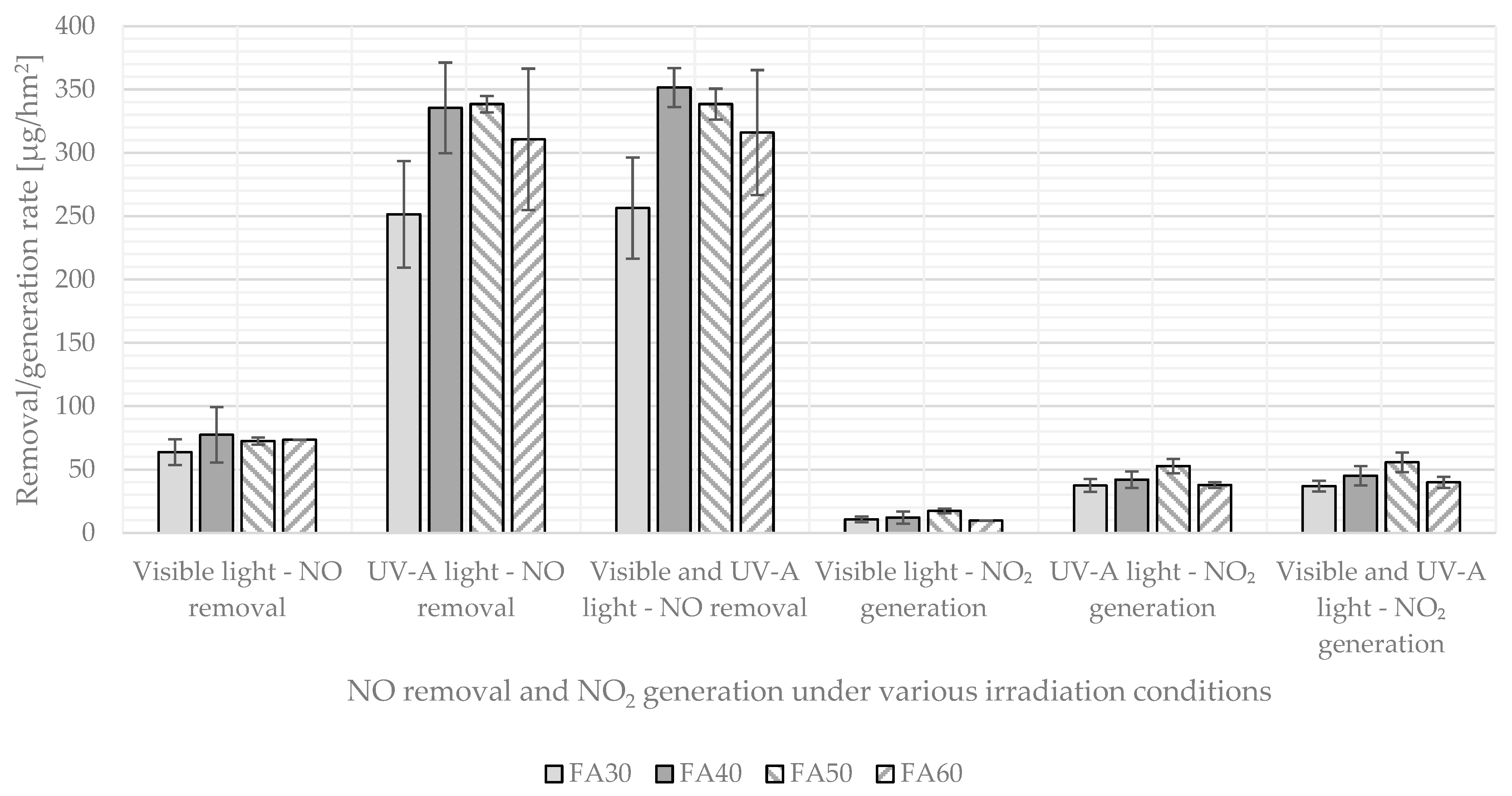
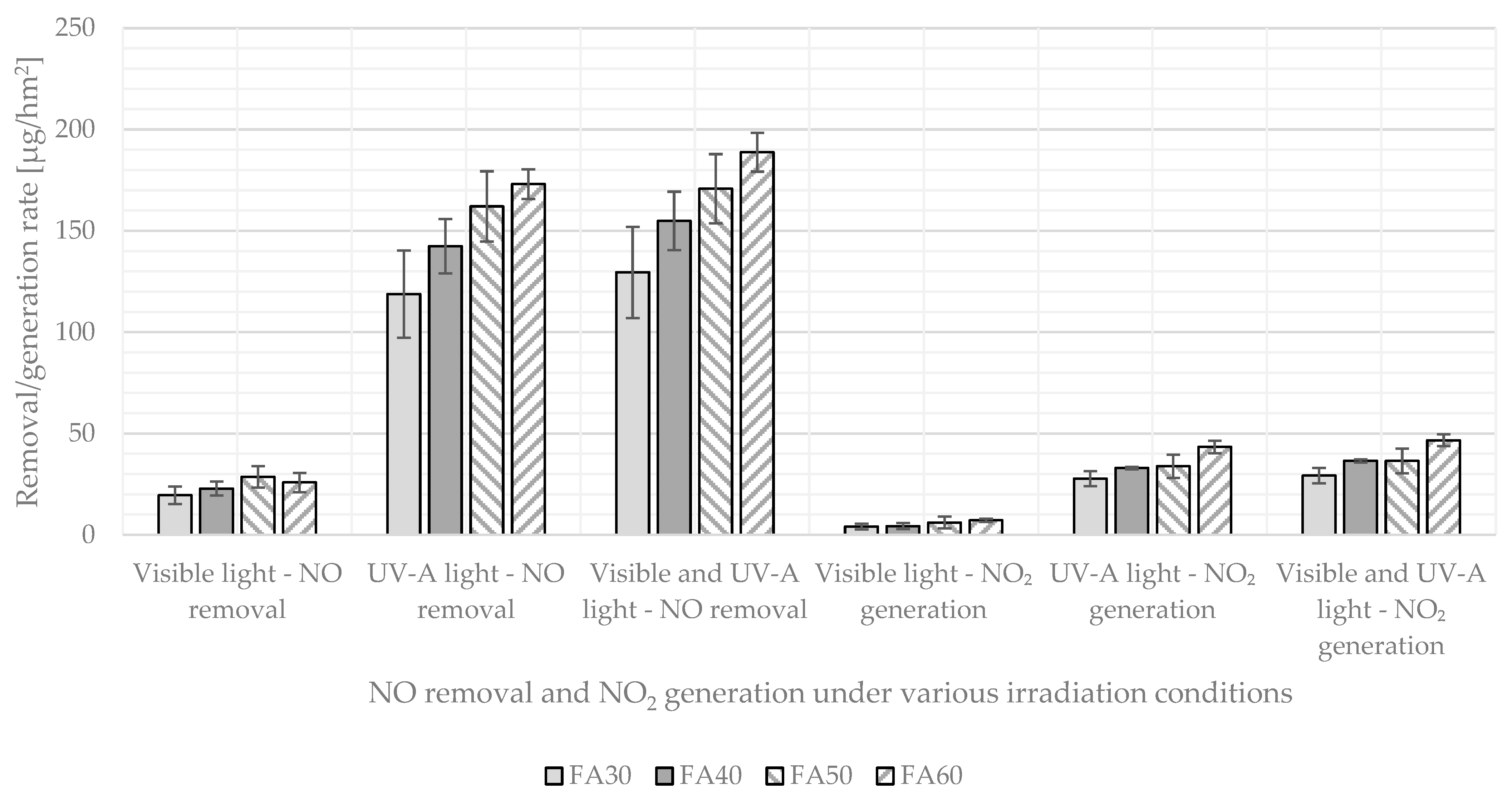
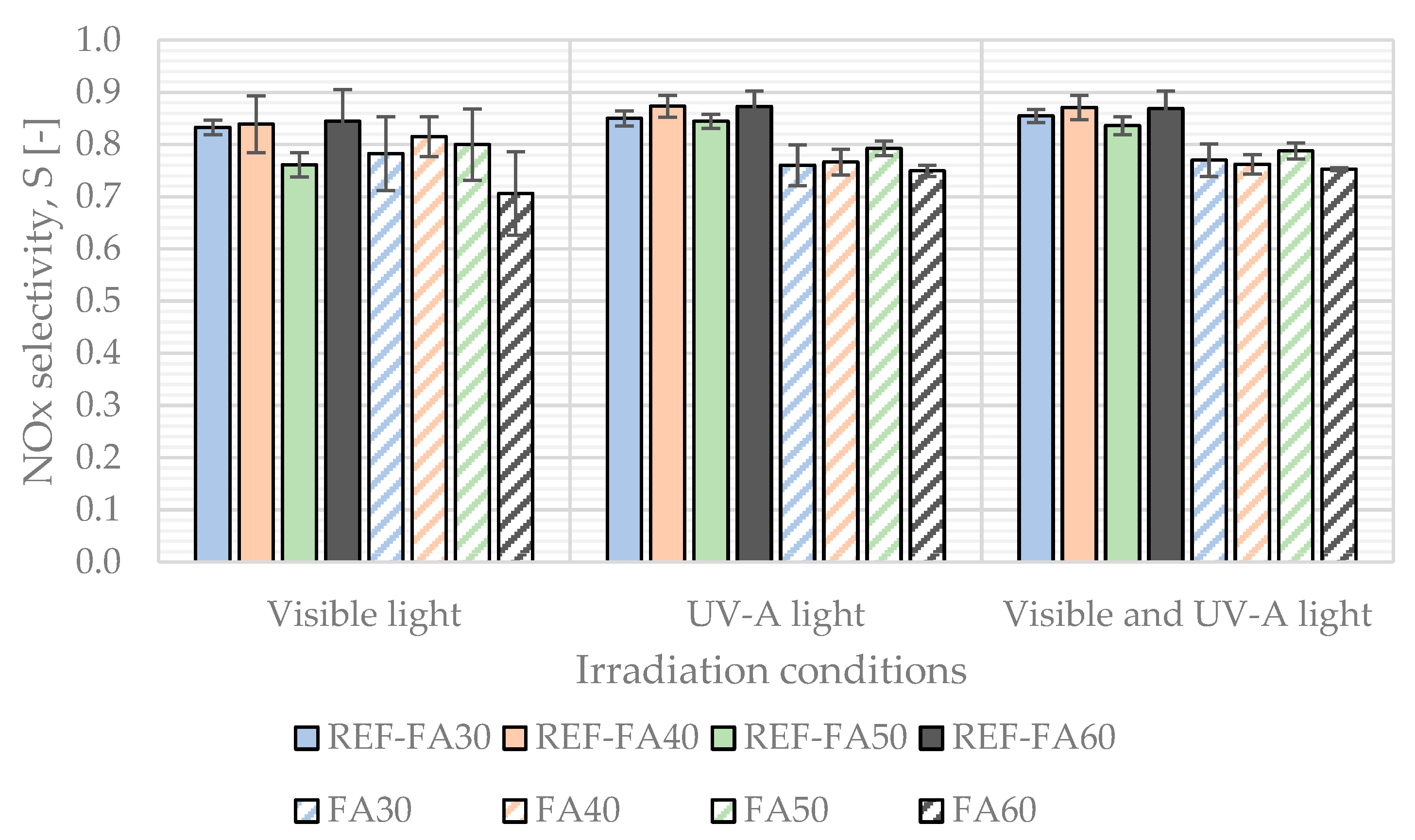

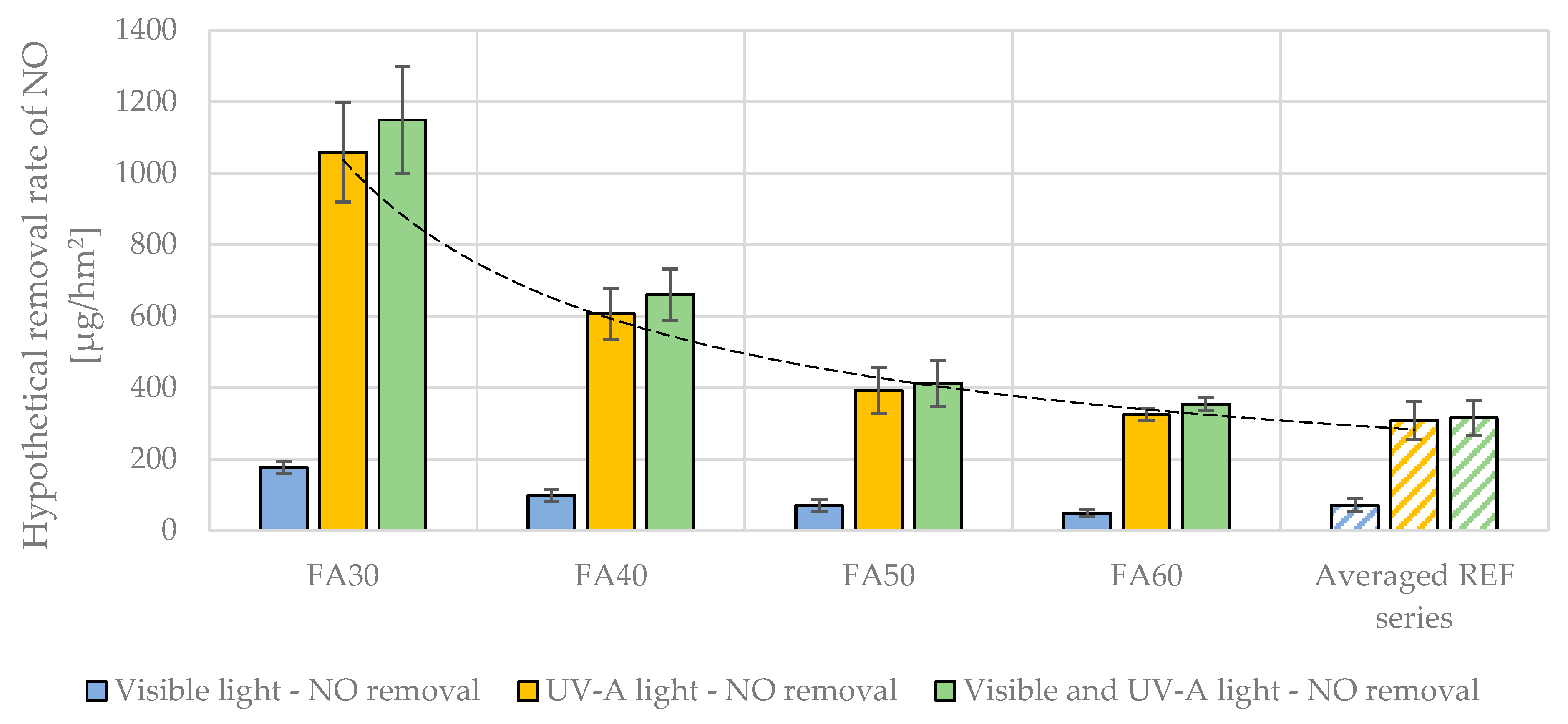
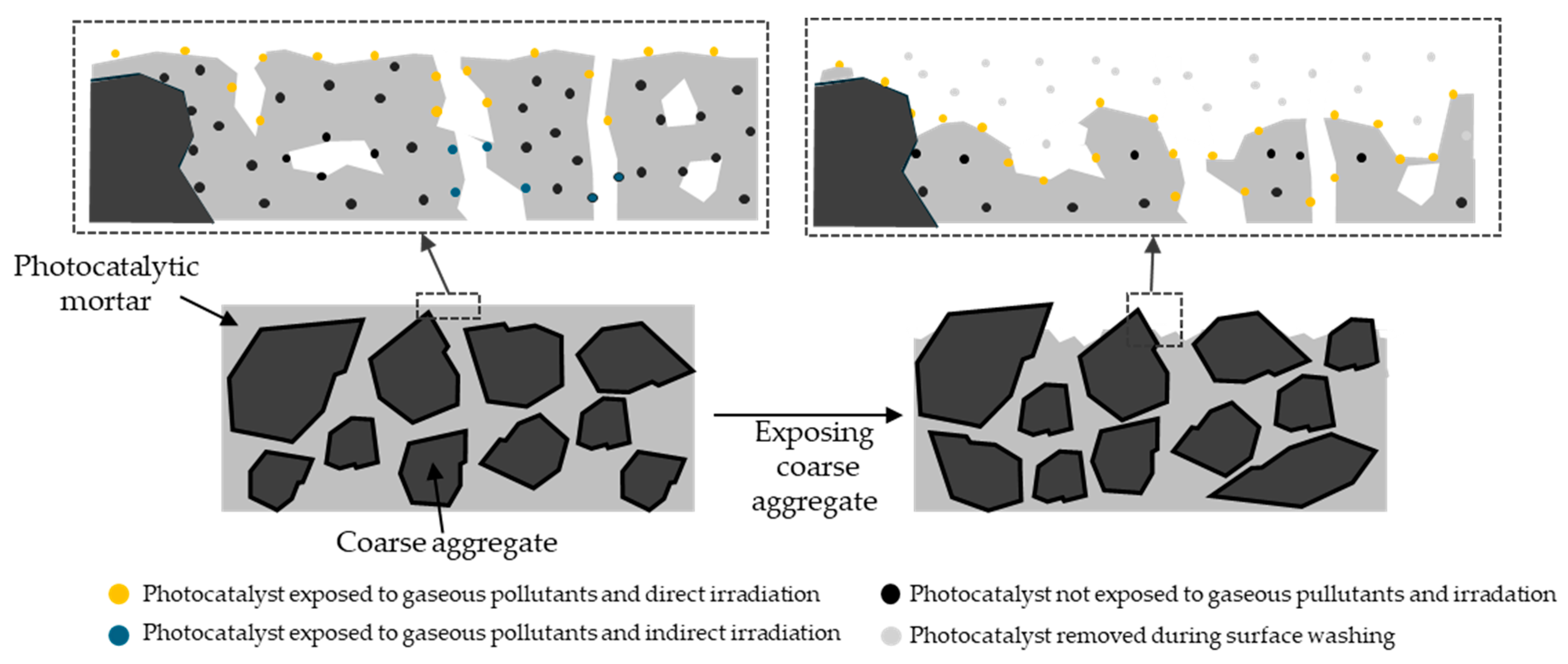
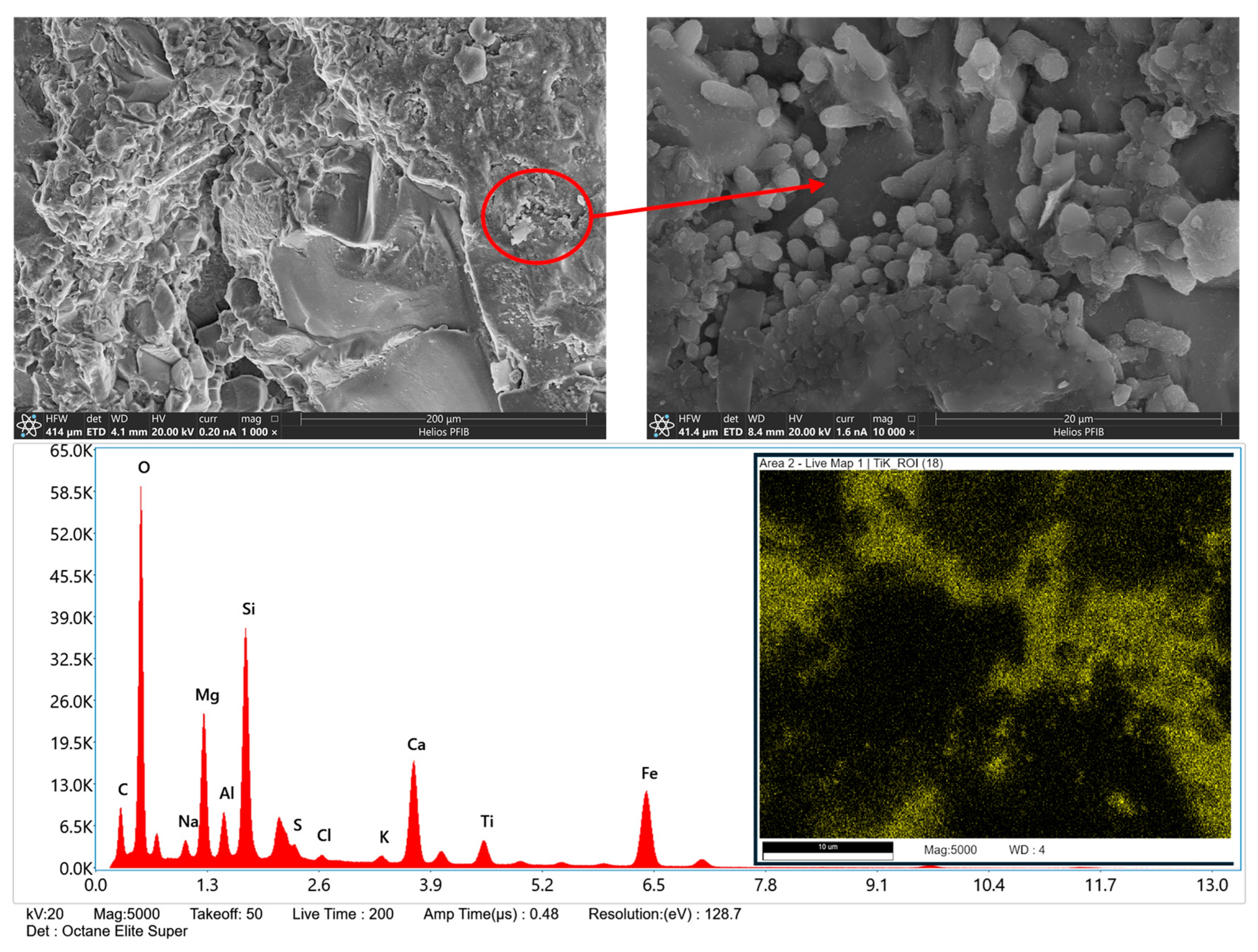
| Flexural Strength, MPa | Compressive Strength, MPa | Initial Setting Time, min | Final Setting Time, min | Specific Gravity, g/cm3 | Specific Surface Area, cm2/g |
|---|---|---|---|---|---|
| 6.8 | 42.7 | 210 | 350 | 2.99 | 4830 |
| Phase Composition (XRD), % | Size of Crystallites (XRD), nm | Specific Surface Area (BET), m2/g | ||
|---|---|---|---|---|
| Rutile | Anatase | Rutile | Anatase | |
| 13 | 87 | 54 | 33 | 53.8 ± 0.2 |
| Unit | FA30 | FA40 | FA50 | FA60 | |
|---|---|---|---|---|---|
| Cement | kg | 420 | |||
| Water | kg | 189 | |||
| Fine aggregate 0/2 | kg | 581 | 763 | 938 | 1108 |
| Coarse aggregate 4/8 | kg | 1356 | 1144 | 938 | 739 |
| Photocatalyst TiO2 | kg | 15 | |||
| Water-to-cement ratio | - | 0.45 | |||
| Cement-to-fine aggregate ratio | - | 0.72 | 0.55 | 0.45 | 0.38 |
| Fine aggregate 0/2 | % m.a. | 30 | 40 | 50 | 60 |
| Coarse aggregate 4/8 | % m.a. | 70 | 60 | 50 | 40 |
| Series ID | Compressive Strength [MPa] | Standard Deviation (SD) [MPa] |
|---|---|---|
| FA30 | 50.12 | 1.08 |
| FA40 | 43.61 | 1.36 |
| FA50 | 46.36 | 0.66 |
| FA60 | 37.05 | 1.23 |
Disclaimer/Publisher’s Note: The statements, opinions and data contained in all publications are solely those of the individual author(s) and contributor(s) and not of MDPI and/or the editor(s). MDPI and/or the editor(s) disclaim responsibility for any injury to people or property resulting from any ideas, methods, instructions or products referred to in the content. |
© 2024 by the authors. Licensee MDPI, Basel, Switzerland. This article is an open access article distributed under the terms and conditions of the Creative Commons Attribution (CC BY) license (https://creativecommons.org/licenses/by/4.0/).
Share and Cite
Chilmon, K.; Kalinowski, M.; Jackiewicz-Rek, W. Influence of Coarse Aggregate Exposure on Air Purification Efficiency in Photocatalytic Cement Composites. Buildings 2024, 14, 3639. https://doi.org/10.3390/buildings14113639
Chilmon K, Kalinowski M, Jackiewicz-Rek W. Influence of Coarse Aggregate Exposure on Air Purification Efficiency in Photocatalytic Cement Composites. Buildings. 2024; 14(11):3639. https://doi.org/10.3390/buildings14113639
Chicago/Turabian StyleChilmon, Karol, Maciej Kalinowski, and Wioletta Jackiewicz-Rek. 2024. "Influence of Coarse Aggregate Exposure on Air Purification Efficiency in Photocatalytic Cement Composites" Buildings 14, no. 11: 3639. https://doi.org/10.3390/buildings14113639
APA StyleChilmon, K., Kalinowski, M., & Jackiewicz-Rek, W. (2024). Influence of Coarse Aggregate Exposure on Air Purification Efficiency in Photocatalytic Cement Composites. Buildings, 14(11), 3639. https://doi.org/10.3390/buildings14113639










